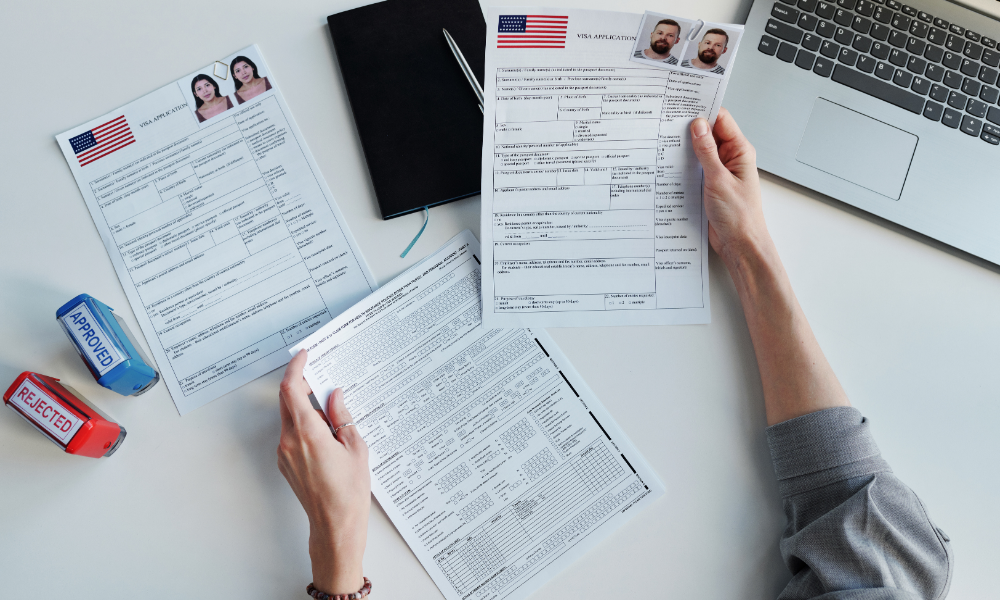Table of Contents
- The Challenge — Navigating Philippine Work Visa Complexities
- Understanding Work Visa Types in the Philippines
- The 3 Most Common Work Authorization Routes
- The AEP — Your First Gatekeeper
- The Full Visa Flow (If You’re Going for 9(g)):
- Why This Is So Difficult for Foreign Companies
- Here’s What “Setting Up A Company” Really Means
- Why This Route Fails Most Foreign Businesses
- What Is An EOR?
- Why Global Companies Are Turning to EORs
- When Should You Use An EOR?
- Frequently Asked Questions — Work Visas In The Philippines (For Employers)
- Make Global Expansion Easy
You finally closed the deal.
Your team crushed the pitch, the client’s onboard, and the project starts next month.
There’s just one problem:
You need boots on the ground in the Philippines.
And suddenly, that dream project feels like it’s wrapped in red tape.
You ask your HR team to sort out the paperwork. They come back looking pale.
“We need a local entity.”
“There’s a 40-day approval process.”
“We need to apply for something called an AEP… then a 9(g) visa… and maybe a provisional permit if we’re lucky.”
You weren’t planning on becoming an immigration expert.
You just need your team where the work is.
Sound familiar?
You’re not alone. This is the part nobody talks about when companies go global.
They tell you about scaling. About going cross-border. About unlocking talent and delivering value anywhere in the world.
What they don’t tell you… is how fast that momentum can slam into a brick wall — if you don’t know how to move compliantly, quickly, and smart.
And nowhere is that truer than the Philippines.
At Hexa Business, we’ve helped companies just like yours — tech giants from India, project teams from the US, and scaling startups from Europe — deploy foreign talent to the Philippines without setting up a local entity, navigating a mountain of paperwork, or risking non-compliance.
In this guide, we’ll walk you through exactly how it works — what kind of work visas are available, what the government expects, what pitfalls to avoid, and how to move fast without breaking the rules.
Because when the opportunity is in front of you, the last thing you need is immigration red tape holding you back.
The Challenge — Navigating Philippine Work Visa Complexities
You don’t need to Google “how to get a work visa in the Philippines” to know what’s coming.
Because the moment you try to send a foreign employee there — an Indian tech lead, an American project manager, a European compliance consultant — you hit the same wall.
Visas, Permits, Paperwork, Waiting
And the questions start piling up:
- Do we need to set up a local entity first?
- Can we sponsor a work visa as a foreign company?
- What kind of permit do we need — 9(g)? SWP? Something else?
- How long will it take?
- What if the project starts next month?
It’s like stepping into a maze with no map.
Everything is acronym soup. The rules are vague. The processing times shift. And half the “guides” online were written in 2017 and never updated.
Here’s the reality most companies don’t realize until it’s too late:
You can’t hire or deploy a foreign national in the Philippines — not legally — without jumping through very specific immigration and labor hoops.
And those hoops are designed for companies who already have a legal presence inside the Philippines.
Meaning: If you don’t have a registered Philippine entity, you can’t legally sponsor a 9(g) employment visa.
Which means your only options are to either:
- Spend 6–12 months setting up a local subsidiary
- Or… find someone who already has one, and can sponsor your staff on your behalf
(Hint: that’s where Employer of Record providers come in — but we’ll get to that.)
For now, what matters is this:
Most foreign businesses trying to deploy staff into the Philippines are flying blind.
They don’t understand the local visa system.
They don’t know what paperwork they need.
And they don’t realize that getting it wrong could mean visa denials, fines, or worse — permanent bans.
This next section breaks it all down.
Every type of work visa. Who it’s for. How to get it. And what it really takes.
No fluff. No guesswork. Just straight answers.
Understanding Work Visa Types in the Philippines
So now you’re thinking:
Okay, I get that I need a visa — but which one? And how do I even start?
Good question. Because this is where 90% of businesses get stuck.
There’s no single “work visa” for the Philippines.
Instead, there’s a series of permits, processes, and visa categories — and if you don’t get them in the right order, your application gets kicked back… or worse, your employee gets denied entry altogether.
Let’s break it down step by step.

The 3 Most Common Work Authorization Routes
Each type has a specific use case. Choose wrong, and you risk delays. Choose right, and you’re in business.
1. 9(g) Pre-Arranged Employment Visa (Commercial)
The gold standard for long-term expat deployment.
Use this if: You’re hiring a foreign national to work full-time for your company in the Philippines for 6+ months.
Requirements:
- A Philippine-based company must sponsor the visa (this is where EORs come in)
- An approved Alien Employment Permit (AEP) from the Department of Labor and Employment (DOLE)
- A personal appearance at the Bureau of Immigration (for biometrics)
Process Timeline:
- AEP: ~10–15 working days
- 9(g) filing: After AEP approval
- Visa approval: ~2 to 2.5 months
- Visa stamping + ACR I-Card: ~7–10 days after approval
Total Timeframe: Around 3 months from job posting to final visa issuance — if done correctly.
Pro Tip: Your foreign staff must enter on a 9A tourist visa first and transition to 9(g) inside the country. If they need to work while waiting, you’ll need a…
2. Provisional Work Permit (PWP)
Temporary authorization to work while your 9(g) is processing.
Use this if: You can’t wait 2–3 months for the 9(g) to finalize.
Requirements:
- A filed and paid AEP application
- Proof of ongoing 9(g) visa process
Validity: 3 months or until the 9(g) is approved — whichever comes first
Processing Time: 2–4 working days after submission
Pro Tip: You can apply for the PWP 3–5 days after AEP filing. This lets your expat hit the ground running.
3. Special Work Permit (SWP)
For short-term projects (less than 6 months)
Use this if: You need someone in-country fast for a temporary assignment or consultancy role.
Requirements:
- A sponsoring Philippine entity
- Tourist visa holder status
- No criminal record
Processing Time: 2–3 weeks
Limitations:
- Max duration = 6 months (non-extendable)
- Holder remains classified as a tourist (limited activities permitted)
Use case: Consultants, auditors, tech specialists on a short gig.
ALSO READ: ‘I’m a startup. How can I have my own Human Resources and Finance team?’
The AEP — Your First Gatekeeper
No matter what visa you choose, you’ll likely need an AEP.
Alien Employment Permit (AEP) = government clearance stating no Filipino is available for the role.
Steps:
- Job posting on PhilJobNet + local newspaper (lead time = 15 days each)
- Submit to DOLE with supporting docs
- Receive your AEP card (valid for 1 year, renewable)
Processing Time: 10–15 working days after publication ends
Pro Tip: AEP must be filed before work begins — or you’ll be penalized.
The Full Visa Flow (If You’re Going for 9(g)):
Here’s what the ideal process looks like, assuming your foreign talent enters on a 9A visa:
- Job published on PhilJobNet & newspaper (30-day lead time)
- Apply for AEP at DOLE (~2 weeks after publication)
- Apply for PWP after AEP filing (optional but recommended)
- Apply for 9(g) visa after AEP card is released
- Appear for biometrics + wait for visa approval (~2–2.5 months)
- Receive ACR I-Card + visa stamping (7–10 working days)
Why This Is So Difficult for Foreign Companies
Most of this process requires a local Philippine entity to sponsor, publish, and apply.
If you don’t have one, you’re stuck.
Or…
you partner with a Philippine-based Employer of Record (EOR) who can sponsor your expat staff under their legal entity — and manage every step on your behalf.
The Traditional Route — Establishing a Local Entity
If you ask most immigration lawyers how to get a work visa in the Philippines,
they’ll give you the same answer:
You’ll need to register a company in the Philippines first.
Sounds simple enough, right?
Until you realize what that actually involves.
Here’s what “setting up a company” really means:
- Register with the Securities and Exchange Commission (SEC)
- Secure local Mayor’s Permit and Barangay Clearance
- Open a Philippine corporate bank account
- Register with BIR (Bureau of Internal Revenue) for tax compliance
- Enroll in government agencies: SSS, PhilHealth, Pag-IBIG
- Appoint resident directors and officers (who must often be locals)
- Maintain monthly compliance filings, even when dormant
And that’s before you’ve even applied for a single work visa.
Let that sink in.
You’ll spend 3–6 months and burn through thousands of dollars
just to get permission to start applying for a work permit.
All to send one expat employee to deliver on a project.
ALSO READ: The Impact of Employer of Record for Global Outsourcing in 2025

Why This Route Fails Most Foreign Businesses
Let’s be real:
- It’s slow — even if you have a corporate services team on speed dial
- It’s expensive — you’re paying for legal, accounting, payroll, HR, compliance, office leasing
- It’s permanent — once you’re in the system, you’re required to file reports, pay taxes, and comply even if your project ends
- It’s inflexible — good luck pivoting quickly if the market shifts
It’s like building a house to host one dinner party.
Sure, if you plan to hire a full Philippine team, run operations long-term, and have millions to invest — setting up a local entity might make sense.
But if you just need to deploy one or two resources for 6–18 months to fulfill a client contract?
This route is overkill.
It’s risk-heavy.
And it’s painfully outdated.
In 2025, there’s a better way to put foreign staff on the ground — without the paperwork nightmare.
Let’s talk about that next.
The Better Way — Leveraging an EOR (Employer of Record)
You’ve seen the maze.
The permits.
The timelines.
The endless forms and government offices.
And if you don’t have a legal entity in the Philippines?
You’re stuck at square one.
But what if there was a way to bypass the red tape… without breaking the law, your timeline, or your budget?
There is.
It’s called an Employer of Record (EOR).
What Is an EOR?
An Employer of Record is a legally registered entity in the Philippines that hires and hosts your employees on your behalf.
They become the legal employer — but you retain full operational control of the staff.
Think of it as a local partner who handles compliance, so you can focus on delivery.
Here’s What an EOR Does:
- Sponsors work visas and employment permits
- Handles payroll, tax, and government compliance
- Manages contracts and onboarding
- Ensures your staff are legal, protected, and deployed fast
Here’s What You Avoid:
- Incorporating a company
- Navigating Philippine labor law alone
- Managing government filings, tax registration, HR reporting
- Getting stuck in 3-month setup cycles
Why Global Companies Are Turning to EORs
Let’s say you’re:
- An Indian IT company that just won a 12-month project in Makati
- A European fintech needing an implementation lead on the ground
- A US-based startup hiring a regional marketing director
You don’t want to spend 6 months and $20,000 setting up a business just to place one or two employees.
With an EOR like Hexa, here’s what happens instead:
- You sign a service agreement
- We sponsor the employee’s 9(g) visa
- We manage the AEP, PWP, and compliance
- Your staff is on the ground in 30–60 days — legal, secure, and focused
And You Stay in Control
- You choose who to hire
- You set the KPIs
- You manage the work
- We handle the backend mess
What About Risk?
We get this question all the time:
But what if we lose control?
With a compliant EOR, you don’t.
In fact, you gain more control — because your operations don’t get hijacked by paperwork.You grow faster.
You deploy cleaner.
You protect your client relationships from visa or labor delays.
When Should You Use an EOR?
- You need to send expat staff into the Philippines fast
- You don’t have — or don’t want — a local entity
- You’re testing a new market
- You have short-to-medium term project deployments
- You want to stay 100% compliant without learning immigration law
Hexa’s Advantage
At Hexa, we’ve helped clients from India, the U.S., Europe, and Southeast Asia deploy foreign professionals across the Philippines without a single visa rejection.We manage the timeline.
We keep you compliant.
We take care of the chaos, so you can take care of business.

Case Study
From Zero to Scaled: How One Indian IT Firm Entered the Philippines Without Breaking a Sweat
When an Indian IT services company landed a multi-year tech infrastructure contract in the Philippines, they were thrilled.
But behind the celebration came a hard realization:
We need eight engineers on the ground. Fast. We don’t have a local entity. And the client’s expecting deployment next month.
They were out of time, out of options, and on the verge of losing the contract.
That’s when they called us.
We walked them through exactly what needed to happen — no sugarcoating, no legalese.
Step one: get each expat into the country legally.
We arranged PWP applications (Provisional Work Permits) so they could begin work while their long-term visas processed. All eight expats were on-site, compliant, and operational within weeks.
Step two: scale responsibly.
When the project grew beyond expectations, they needed seven more specialists deployed. We got them in — quickly and cleanly.
Step three: build the local team.
As the scope expanded, they needed local talent to support operations. We helped them hire, onboard, and manage those employees under our EOR model — no entity needed.
And then came the best part.
After 18 months of successful project delivery, their business in the Philippines had matured.
The risk was gone. The upside was clear.
So they set up their own Philippine entity — and we helped them do it.
We transitioned every expat and local hire to their new company structure, seamlessly and compliantly.
No disruption.
No risk.
Just growth, executed the right way.
This is what global expansion should look like.
Not red tape.
Not legal nightmares.
Just smart entry, strong delivery, and a graceful transition to independence.
At Hexa, we don’t just keep you compliant — we help you scale intelligently.
Start lean.
Grow clean.
Go big.
ALSO READ: ‘We’ve business development to expand abroad; how can I build my remote team?’
Frequently Asked Questions — Work Visas in the Philippines (For Employers)
Can I sponsor a work visa in the Philippines if I don’t have a local entity?
No — not directly.
The Philippine government requires a Philippine-registered company to sponsor most long-term work visas, including the 9(g) visa.
But that’s exactly why Employer of Record (EOR) solutions exist — so you can sponsor expat staff legally without incorporating locally.
What is the fastest way to get a foreign employee working in the Philippines?
Use the Provisional Work Permit (PWP).
It allows your employee to start working while the 9(g) visa and AEP are still processing.
You can file for a PWP 3–5 days after submitting the AEP — and usually get approval within 2–4 working days.
What’s the difference between a 9(g) visa and an SWP?
| 9(g) Visa | Special Work Permit (SWP) |
| Long-term work visa | Short-term work authorization (6 months) |
| Requires AEP + local sponsorship | Used for consultants or temp staff |
| Results in full employment status | Holder stays on tourist visa |
Use 9(g) for full-time expats, SWP for temporary, non-renewable assignments.
How long does the 9(g) visa process take?
Approximately 2 to 2.5 months after filing, plus 7–10 days for visa stamping and ACR I-Card issuance.
This does not include the lead time for job posting and AEP approval, which adds another 3–4 weeks.
Tip: Use a PWP to bridge the gap so your team doesn’t sit idle.
What is an Alien Employment Permit (AEP) and why is it needed?
The AEP is issued by the Department of Labor and Employment (DOLE) to confirm that there is no qualified Filipino available for the position.
It’s a mandatory prerequisite for the 9(g) visa.
Can my foreign employees start working while their visa is being processed?
Yes — but only if they have a Provisional Work Permit (PWP) issued by the Bureau of Immigration.
Without it, working before a visa is approved is illegal, even if they’re in the country.
What are the risks of doing this incorrectly?
- Visa denials or blacklisting
- Fines and penalties from the Bureau of Immigration
- Potential ban on future visa applications
- Loss of project delivery credibility with clients
In short: don’t wing it.
Do I need to worry about payroll, tax, and benefits when using an EOR?
Not directly.
Your EOR handles all compliance obligations:
- Payroll and tax withholdings
- SSS, PhilHealth, Pag-IBIG contributions
- Mandatory government filings
You simply fund a consolidated monthly invoice — and we do the rest.
What happens when I’m ready to set up my own entity?
Easy — we help you transition.
At Hexa, we’ve helped multiple clients go from EOR-hosted to fully incorporated companies, migrating all expats and local hires without disruption.
It’s part of our “enter, scale, own” philosophy:
Start lean, prove the market, then take full control.
Make Global Expansion Easy
You didn’t come this far to be stopped by bureaucracy.
You didn’t land the deal, build the momentum, and line up the right people — only to get tangled in a maze of government forms and compliance checklists.
You came to deliver.
To win.
To build something that works — globally.
And here’s the truth:
Expanding into the Philippines doesn’t have to mean setting up a company, hiring an immigration lawyer, or praying your visas get approved.
There’s a smarter way.
You start lean.
You deploy fast.
You stay compliant.
And when the time is right — you transition, scale, and own the market on your terms.
That’s what global business should feel like.
Not panic.
Not paperwork.
Just progress — one smart move at a time.
Let’s Make This Easy
At Hexa, we’ve helped companies across India, the U.S., Europe, and Southeast Asia deploy hundreds of expat and local hires in the Philippines — quickly, compliantly, and without the drama.
Whether you need to send one senior engineer or an entire delivery team, we’ll take care of the work visa maze — so you can stay focused on the mission.
Let’s help you enter, scale, and thrive.






